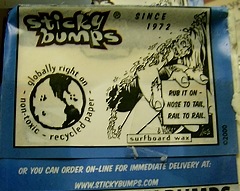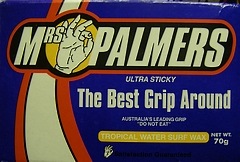 I figured I was uniquely qualified – knowing the stiff and austere demeanor of the Trout Underground, if either of us was capable of “hanging ten” it would be us native Californian’s, bro…
I figured I was uniquely qualified – knowing the stiff and austere demeanor of the Trout Underground, if either of us was capable of “hanging ten” it would be us native Californian’s, bro…
I routinely hang about 36, but that’s over my belt …
Like the Picante sauce, I’m not so sure dry fly purist’s aren’t always from out-of-state, fleeing to the coast to out themselves from whatever depraved closet their skeletons are hid.
I sure don’t fit the tawny, golden stereotype; don’t go near the surf without a sand spike and a couple pounds of anchovies, Speedo’s would cut off all blood to my entire body (and drain the blood of onlookers), so that’s out of the question – but if you wanted a treatise on surfboard wax, I’m learning more than I care to – and more product is enroute.
I’m still adjusting to their technical lingo, but as far as I can tell they’re the only fellows doing to wax what we’re doing to carbon fiber, and with the advent of numerous synthetic waxes – free of paraffin – this is where we’ll find the next really clever replacement to the toilet ring.
… and there’s much less tendency for strangers to recoil from a pasty brownish lump if reassured it belongs on a surfboard, versus a lavatory.
 Tropical, Cold, and Lukewarm, describe the melt point of the material so it doesn’t slough off once applied. It also describes whether it’ll be stiff or soft at room temperature and how it’ll wear with you running threads and other materials over its surface.
Tropical, Cold, and Lukewarm, describe the melt point of the material so it doesn’t slough off once applied. It also describes whether it’ll be stiff or soft at room temperature and how it’ll wear with you running threads and other materials over its surface.
I’m trying all three temperatures just to see what the differences are to the touch – and despite the claims of “super tacky” or “stickiest” there’s considerable differences in each compound.
Wax has fallen from grace over the last 20 years, and those that learned during those years don’t use it – despite the continued use of materials we tamed with wax many decades ago. I’d attribute that to the fly tying thread industry – whose unyielding-decidedly-unsticky version used on pre-waxed thread turned off an entire generation of tiers to its benefits.
Now that I can get a synthetic wax – yet still choose between coconut, mango, bubblegum, or anchovy scents, I’ll be the bane of sausage dogs the north woods.
I use wax on many materials unrelated to thread, it’s water repelling characteristics are especially useful for those thin, tight dry fly bodies, and can counteract the absorbent fur nemesis to some degree.
Considering 70 grams of wax is a decade, 99¢ worth is a prudent investment, half the price of a toilet gasket and in line with the New Frugality, and as the advert mentions, it’s globally right on, Bra ..
… and yes, TC – you can test the Sex Wax …

Wax? And “stiff & austere” for the guy who thought the Buff Babe could have done with a little less fabric?
Check out the waxes made by Bohning for bow strings.
As always you’re on target, Alex. I’ve got a couple of leads to different areas that incorporate synthetic (or natural) waxes.
Surf wax is better only because it gives you an icebreaker to engage all those gals tanning themselves at the beach …
“Excuse me, but which wax do you use?” – (stutter) for your board I mean …
Ha!
There was another company that made bow string wax, but I can’t remember their name. The wax was a deep purple/black color- really good stuff.
Rub on, rub off…
…just call me MR. Zog.
http://www.sexwax.com/main.html
Hmm, very interesting. Me wonders if you are waxing flies before flinging?
Some elements of fly construction take wax better than floatant. Running a quick layer of “cold” wax (remains transparent and flexible in cold water) – can aid the water resistance of the fly.
One prime example that comes to mind is the stripped peacock quill body of the Quill Gordon (and others) – wax will make a flexible bond on that material – where regular floatant (liquid) will not.
I use paste floatant for the same reason – better adhesion on some materials (and some temps)